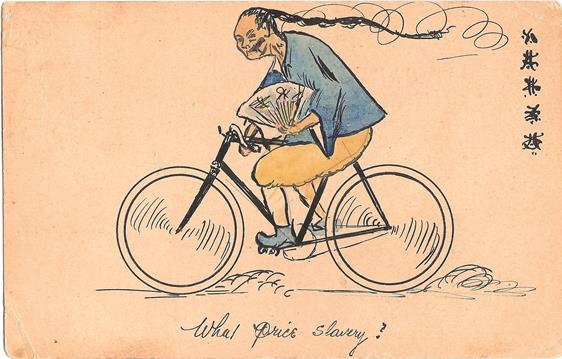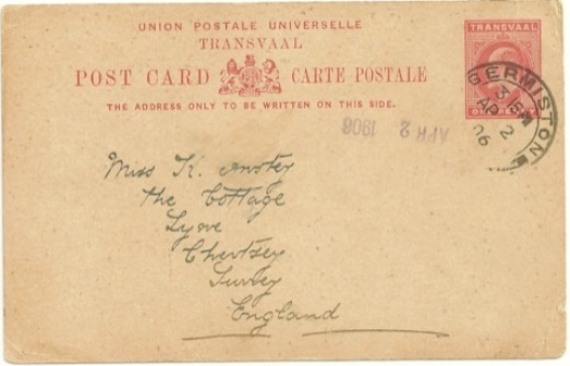TRANSVAAL INDENTURED CHINESE LABOUR
HAND DRAWN CARTOON POSTAL STATIONERY CARD
“WHAT PRICE SLAVERY ?”
Jeff Woolgar


There have been few published articles regarding Transvaal, hand drawn, cartoon, postal stationery cards.1 The example here is therefore, something of a novelty.1a However, it may not be a unique design, and the sender was probably not the artist.
The Edwardian one penny postal stationery card is addressed to England, and entered the post at Germiston on the 2nd April 1906. On the back is a hand drawn, colour cartoon of a Chinaman riding a bicycle, whilst holding a fan and smoking a cigar. The small characters running down the right side, are crude imitations of Chinese characters, which suggest that the artist was not Chinese.
The cartoon and manuscript caption ‘What price slavery ?’ alludes to reports given around 1906, in some newspapers, privately published pamphlets and accounts from China.2 Thus reporting that the Chinese indentured labourers on the Witwatersrand, had money to spare. They tell of labourers returning to China dressed in European clothes, carrying Zulu shields, assegais, knobkerries, fly-flickers and other mementos.
However, reports of labourers returning home with gold watch chains, bicycles, etc. are questioned by at least one newspaper which published photographs together with the statement that: ‘It may be noted that the coolies’ photographs we give show no outward and visible sign of this opulence’.3
Others cited the high cost of living on the Witwatersrand: 'The average wages paid to these coolies was about 40/- for 30 shifts. After buying milk, sugar, tobacco, and other things which they required there was little or nothing left to send to their families in China.' 'In the Straits Settlements the current wages were 2/- per day, which, when the purchasing power is considered, gave a much larger margin than they have on the Rand.'4
This type of card would have been popular in the Johannesburg district during 1906, when debates on the future of Chinese labour were in the public domain.
Acknowledgments
I thank Christopher Board, Gregory Loh, Joan Matthews and Ann Stone for their helpful comments.
References
1. Taylor, J., (1995), Illustrated postcards, The Transvaal Philatelist, Vol.30, (114), pp.63-4, and (115), p.vii.
1a. Woolgar, J., (2005), A picture postcard drawn on leather, The Transvaal Philatelist, Vol.40, p.15.
2.Woolgar, J., (2010), Chinese Indentured Labour on the Witwatersrand Gold Fields illustrated by Picture Postcards published between 1904 and 1910, including an analysis of postcard and covers, p.19, England.
3. The Illustrated London News, 15th September 1906 and 28th August 1907.
4.Burt, T., M.P., (1905), A Visit to the Transvaal; Labour: White, Black, and Yellow, Newcastle-Upon-Tyne also at Manchester and London,, p.61.
-- 'The Elgin Dispatch' --